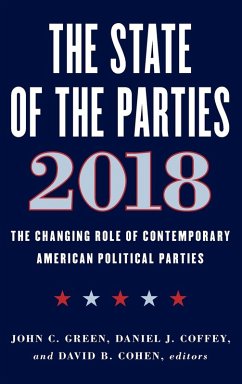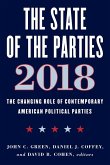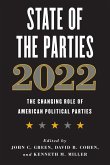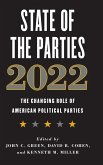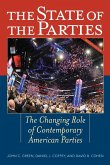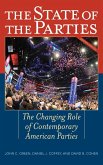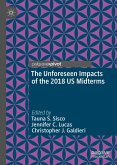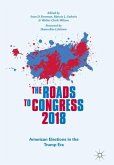The State of the Parties 2018
The Changing Role of Contemporary American Political Parties
Herausgeber: Green, John C.; Coffey, Daniel J.
The State of the Parties 2018
The Changing Role of Contemporary American Political Parties
Herausgeber: Green, John C.; Coffey, Daniel J.
- Gebundenes Buch
- Merkliste
- Auf die Merkliste
- Bewerten Bewerten
- Teilen
- Produkt teilen
- Produkterinnerung
- Produkterinnerung
The State of the Parties 2018 brings together leading scholars of parties, elections, and interest groups to provide an indispensable overview of American political parties today.
Andere Kunden interessierten sich auch für
![The State of the Parties 2018 The State of the Parties 2018]() The State of the Parties 201859,99 €
The State of the Parties 201859,99 €![State of the Parties 2022 State of the Parties 2022]() David B. CohenState of the Parties 202255,99 €
David B. CohenState of the Parties 202255,99 €![State of the Parties 2022 State of the Parties 2022]() State of the Parties 2022134,99 €
State of the Parties 2022134,99 €![The State of the Parties The State of the Parties]() The State of the Parties81,99 €
The State of the Parties81,99 €![The State of the Parties The State of the Parties]() The State of the Parties174,99 €
The State of the Parties174,99 €![The Unforeseen Impacts of the 2018 US Midterms The Unforeseen Impacts of the 2018 US Midterms]() The Unforeseen Impacts of the 2018 US Midterms37,99 €
The Unforeseen Impacts of the 2018 US Midterms37,99 €![The Roads to Congress 2018 The Roads to Congress 2018]() The Roads to Congress 201874,99 €
The Roads to Congress 201874,99 €-
-
-
The State of the Parties 2018 brings together leading scholars of parties, elections, and interest groups to provide an indispensable overview of American political parties today.
Hinweis: Dieser Artikel kann nur an eine deutsche Lieferadresse ausgeliefert werden.
Hinweis: Dieser Artikel kann nur an eine deutsche Lieferadresse ausgeliefert werden.
Produktdetails
- Produktdetails
- Verlag: Rowman & Littlefield Publishers
- Seitenzahl: 346
- Erscheinungstermin: 25. September 2018
- Englisch
- Abmessung: 235mm x 157mm x 25mm
- Gewicht: 713g
- ISBN-13: 9781538117651
- ISBN-10: 1538117657
- Artikelnr.: 53022559
- Herstellerkennzeichnung
- Books on Demand GmbH
- In de Tarpen 42
- 22848 Norderstedt
- info@bod.de
- 040 53433511
- Verlag: Rowman & Littlefield Publishers
- Seitenzahl: 346
- Erscheinungstermin: 25. September 2018
- Englisch
- Abmessung: 235mm x 157mm x 25mm
- Gewicht: 713g
- ISBN-13: 9781538117651
- ISBN-10: 1538117657
- Artikelnr.: 53022559
- Herstellerkennzeichnung
- Books on Demand GmbH
- In de Tarpen 42
- 22848 Norderstedt
- info@bod.de
- 040 53433511
John C. Green is Distinguished Professor of Political Science and director of the Ray C. Bliss Institute of Applied Politics at The University of Akron. Daniel J. Coffey is associate professor of political science at The University of Akron and a fellow in the Ray C. Bliss Institute of Applied Politics. He has published in State Politics and Policy Quarterly. He studies political parties, public opinion, state and local politics, campaigns and elections, and research methods. David B. Cohen is professor of political science and fellow in the Ray C. Bliss Institute of Applied Politics at The University of Akron.
List of Tables List of Figures Acknowledgments Chapter 1. The State of the Parties: Change and Continuity in 2016
by Daniel J. Coffey
David B. Cohen
and John C. Green Part One: State of the Parties Chapter 2. Failing Party Organizations: Lessons from the 2016 Election
by Mildred A. Schwartz Chapter 3. Party Blobs and Partisan Visions: Making Sense of our Hollow Parties
by Daniel Schlozman and Sam Rosenfeld Chapter 4. Saving Democracy from Elections?
by Daniel M. Shea Part Two: Party Activists Chapter 5. The Power of a Narrative: Donald Trump (and the Republicans)
by Jeffrey M. Stonecash Chapter 6. "The Mandate of the People:" The 2016 Sanders Campaign in Context
by Julia Azari and Seth Masket Chapter 7. State Party Activism in 2016
by Daniel J. Coffey Chapter 8. #Polarized2016: Affective Campaign Rhetoric and Mass Polarization in Social Media
by Eric C. Vorst Part Three: Party Nominations Chapter 9. The State of the Primaries 2016
by Drew Kurlowski Chapter 10. Perception of the Parties and the 2016 Presidential Nominations
by Caitlin E. Jewitt Chapter 11. Populist Waves in the 2016 Presidential Nominations: Another Limit to the Party Decides Thesis
by Wayne Steger Part Four: Party in Electorate Chapter 12. Political Identity and Party Polarization in the American Electorate
by David C. Kimball
Joseph Anthony
and Tyler Chance Chapter 13. The Angry American Voter: Negative Partisanship
Voter Anger
and the 2016 Presidential Election
by Alan I. Abramowitz and Steven W. Webster Chapter 14. The Role of the Populists in the 2016 U.S. Presidential Election and Beyond
by Edward G. Carmines
Michael J. Ensley
and Michael W. Wagner Part Five: Party Resources Chapter 15. The 2016 Money Race: The Limits of Campaign Money
and the Nature of Popular Love for the Presidential Candidates
by Robin Kolodny Chapter 16. Everything is Relative: Are Political Parties Playing a Meaningful Campaign Finance Role in the U.S. Federal Elections?
by Diana Dwyre Chapter 17. The Impact of Organization Characteristics on Super PAC Financing
by Paul S. Herrnson
Jennifer A. Heerwig
and Douglas M. Spencer Chapter 18. What Happened to the Ground Game in 2016?
by Paul A. Beck
Richard Gunther
and Erik Nisbet References Index About the Contributors
by Daniel J. Coffey
David B. Cohen
and John C. Green Part One: State of the Parties Chapter 2. Failing Party Organizations: Lessons from the 2016 Election
by Mildred A. Schwartz Chapter 3. Party Blobs and Partisan Visions: Making Sense of our Hollow Parties
by Daniel Schlozman and Sam Rosenfeld Chapter 4. Saving Democracy from Elections?
by Daniel M. Shea Part Two: Party Activists Chapter 5. The Power of a Narrative: Donald Trump (and the Republicans)
by Jeffrey M. Stonecash Chapter 6. "The Mandate of the People:" The 2016 Sanders Campaign in Context
by Julia Azari and Seth Masket Chapter 7. State Party Activism in 2016
by Daniel J. Coffey Chapter 8. #Polarized2016: Affective Campaign Rhetoric and Mass Polarization in Social Media
by Eric C. Vorst Part Three: Party Nominations Chapter 9. The State of the Primaries 2016
by Drew Kurlowski Chapter 10. Perception of the Parties and the 2016 Presidential Nominations
by Caitlin E. Jewitt Chapter 11. Populist Waves in the 2016 Presidential Nominations: Another Limit to the Party Decides Thesis
by Wayne Steger Part Four: Party in Electorate Chapter 12. Political Identity and Party Polarization in the American Electorate
by David C. Kimball
Joseph Anthony
and Tyler Chance Chapter 13. The Angry American Voter: Negative Partisanship
Voter Anger
and the 2016 Presidential Election
by Alan I. Abramowitz and Steven W. Webster Chapter 14. The Role of the Populists in the 2016 U.S. Presidential Election and Beyond
by Edward G. Carmines
Michael J. Ensley
and Michael W. Wagner Part Five: Party Resources Chapter 15. The 2016 Money Race: The Limits of Campaign Money
and the Nature of Popular Love for the Presidential Candidates
by Robin Kolodny Chapter 16. Everything is Relative: Are Political Parties Playing a Meaningful Campaign Finance Role in the U.S. Federal Elections?
by Diana Dwyre Chapter 17. The Impact of Organization Characteristics on Super PAC Financing
by Paul S. Herrnson
Jennifer A. Heerwig
and Douglas M. Spencer Chapter 18. What Happened to the Ground Game in 2016?
by Paul A. Beck
Richard Gunther
and Erik Nisbet References Index About the Contributors
List of Tables List of Figures Acknowledgments Chapter 1. The State of the Parties: Change and Continuity in 2016
by Daniel J. Coffey
David B. Cohen
and John C. Green Part One: State of the Parties Chapter 2. Failing Party Organizations: Lessons from the 2016 Election
by Mildred A. Schwartz Chapter 3. Party Blobs and Partisan Visions: Making Sense of our Hollow Parties
by Daniel Schlozman and Sam Rosenfeld Chapter 4. Saving Democracy from Elections?
by Daniel M. Shea Part Two: Party Activists Chapter 5. The Power of a Narrative: Donald Trump (and the Republicans)
by Jeffrey M. Stonecash Chapter 6. "The Mandate of the People:" The 2016 Sanders Campaign in Context
by Julia Azari and Seth Masket Chapter 7. State Party Activism in 2016
by Daniel J. Coffey Chapter 8. #Polarized2016: Affective Campaign Rhetoric and Mass Polarization in Social Media
by Eric C. Vorst Part Three: Party Nominations Chapter 9. The State of the Primaries 2016
by Drew Kurlowski Chapter 10. Perception of the Parties and the 2016 Presidential Nominations
by Caitlin E. Jewitt Chapter 11. Populist Waves in the 2016 Presidential Nominations: Another Limit to the Party Decides Thesis
by Wayne Steger Part Four: Party in Electorate Chapter 12. Political Identity and Party Polarization in the American Electorate
by David C. Kimball
Joseph Anthony
and Tyler Chance Chapter 13. The Angry American Voter: Negative Partisanship
Voter Anger
and the 2016 Presidential Election
by Alan I. Abramowitz and Steven W. Webster Chapter 14. The Role of the Populists in the 2016 U.S. Presidential Election and Beyond
by Edward G. Carmines
Michael J. Ensley
and Michael W. Wagner Part Five: Party Resources Chapter 15. The 2016 Money Race: The Limits of Campaign Money
and the Nature of Popular Love for the Presidential Candidates
by Robin Kolodny Chapter 16. Everything is Relative: Are Political Parties Playing a Meaningful Campaign Finance Role in the U.S. Federal Elections?
by Diana Dwyre Chapter 17. The Impact of Organization Characteristics on Super PAC Financing
by Paul S. Herrnson
Jennifer A. Heerwig
and Douglas M. Spencer Chapter 18. What Happened to the Ground Game in 2016?
by Paul A. Beck
Richard Gunther
and Erik Nisbet References Index About the Contributors
by Daniel J. Coffey
David B. Cohen
and John C. Green Part One: State of the Parties Chapter 2. Failing Party Organizations: Lessons from the 2016 Election
by Mildred A. Schwartz Chapter 3. Party Blobs and Partisan Visions: Making Sense of our Hollow Parties
by Daniel Schlozman and Sam Rosenfeld Chapter 4. Saving Democracy from Elections?
by Daniel M. Shea Part Two: Party Activists Chapter 5. The Power of a Narrative: Donald Trump (and the Republicans)
by Jeffrey M. Stonecash Chapter 6. "The Mandate of the People:" The 2016 Sanders Campaign in Context
by Julia Azari and Seth Masket Chapter 7. State Party Activism in 2016
by Daniel J. Coffey Chapter 8. #Polarized2016: Affective Campaign Rhetoric and Mass Polarization in Social Media
by Eric C. Vorst Part Three: Party Nominations Chapter 9. The State of the Primaries 2016
by Drew Kurlowski Chapter 10. Perception of the Parties and the 2016 Presidential Nominations
by Caitlin E. Jewitt Chapter 11. Populist Waves in the 2016 Presidential Nominations: Another Limit to the Party Decides Thesis
by Wayne Steger Part Four: Party in Electorate Chapter 12. Political Identity and Party Polarization in the American Electorate
by David C. Kimball
Joseph Anthony
and Tyler Chance Chapter 13. The Angry American Voter: Negative Partisanship
Voter Anger
and the 2016 Presidential Election
by Alan I. Abramowitz and Steven W. Webster Chapter 14. The Role of the Populists in the 2016 U.S. Presidential Election and Beyond
by Edward G. Carmines
Michael J. Ensley
and Michael W. Wagner Part Five: Party Resources Chapter 15. The 2016 Money Race: The Limits of Campaign Money
and the Nature of Popular Love for the Presidential Candidates
by Robin Kolodny Chapter 16. Everything is Relative: Are Political Parties Playing a Meaningful Campaign Finance Role in the U.S. Federal Elections?
by Diana Dwyre Chapter 17. The Impact of Organization Characteristics on Super PAC Financing
by Paul S. Herrnson
Jennifer A. Heerwig
and Douglas M. Spencer Chapter 18. What Happened to the Ground Game in 2016?
by Paul A. Beck
Richard Gunther
and Erik Nisbet References Index About the Contributors

